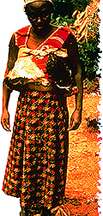

|
|
Peoples of Central Africa Ethnic Groups in Rwanda Rwanda has a population of approximately 7 million. The languages spoken in this
country are French, Kinyarwanda, and Kiswahili; and the religions practiced are Christian,
traditional African, and Muslim. The total population of this country comprises several
peoples, the most predominant of which are the three ethnic groups: the Tutsi, the Hutu,
and the Twa. Photo: Courtesy of
the Dian Fossey Gorilla Fund Ethnic Groups in Rwanda Rwanda has a population of approximately 7 million. The languages spoken in this
country are French, Kinyarwanda, and Kiswahili; and the religions practiced are Christian,
traditional African, and Muslim. The total population of this country comprises several
peoples, the most predominant of which are the three ethnic groups: the Tutsi, the Hutu,
and the Twa. Photo: Courtesy of
the Dian Fossey Gorilla FundThe Twa, a subgroup of the African
Pygmies, are slightly larger than most pygmies. Adult males average 1.5 m (5 ft) and 45 kg
(100 lb). The Twa, the earliest settlers of this area, originally lived off the land as
hunters and gatherers in the once extensive forests around the Virunga Mountains. But as
the forests were cut down--first by the Hutu for farming and grazing, then by the Tutsi
for grazing--the Twa population began to decrease. Today the Twa make up only 1% of the
total population. Compared to the other ethnic groups within Rwandan society, the Twa hold
an inferior position, due to their smaller size and their customs, which are considered
primitive by the Tutsi and Hutu.
The centuries-old social tension between the Tutsi and the Hutu is the primary reason for the unrest and violence that began before Rwandan independence from Belgium in 1962. Before independence, the ruling colonial powers, first Germany and then Belgium, controlled Rwanda by continuing to use the existing Tutsi ruling caste. With independence and majority rule, the Hutu revolted, took control of the government, and violently drove the Tutsi from the country. Civil war has been bloody and ongoing. In 1994, the Tutsi again regained power in Rwanda and drove the Hutu out of the government and the country in a continuing, violent struggle. Ethnic Groups in Congo (formerly Zaire) The Congolese population exceeds 46 million and comprises over 250 African tribal groups. Of these tribal groups, 80% are related to the Bantu tribes. The languages spoken in this country are French as well as about 700 ethnic languages and dialects. Four of these--Lingala, Swahili, Kikongo, and Tshiluba--serve as official languages. The religions practiced are Christian, traditional African, and Muslim. Ethnic Groups in Uganda Uganda has a population of approximately 17 million. This country's native population includes the Bantu, Nilotic, and Nilo-Hamitic peoples. The Bantu population, which includes the Baganda people, numbers approximately 1 million, making it the largest group in the country. The languages spoken in this country are English, Luganda, and several other ethnic languages. The religions practiced are Christian, traditional African, and Muslim.
[ Peoples of Central Africa ] [ Famine in Rwanda ] [ Home ] [ Teacher Pages ] [ Modules & Activities ] |
HTML code by Chris Kreger
Maintained by ETE Team
Last updated April 28, 2005
Some images © 2004 www.clipart.com
Privacy Statement and Copyright © 1997-2004 by Wheeling Jesuit University/NASA-supported Classroom of the Future. All rights reserved.
Center for Educational Technologies, Circuit Board/Apple graphic logo, and COTF Classroom of the Future logo are registered trademarks of Wheeling Jesuit University.